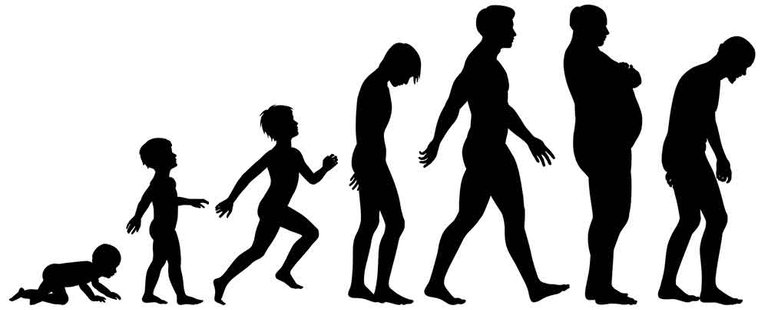PHYSIOLOGY OF AGEING

Doesn't the years just fly by?! It seems as if you were a youngster just the other day but you're celebrating another birthday and those wrinkles are settling in. As a matter of fact everybody want a life where aging is absent but Alas! The concept of aging is a natural phenomenon and as well a largely mysterious process that is above the power of will.
Aging is inevitable and as life expectancy increases it becomes more important to understand physiological mechanism associated with the normal aging so that the quality of life may be sustained. Physiologists are in the ideal position to test hypotheses of how genetic, molecular and cellular mechanism of aging affects human physiology—journal of applied physiology 2003
Aging reflect all the changes that occur over the course of life, it is a process that begins at conception and continues for as long as we live. At any given time throughout our lifespan; the body reflects;
- It’s genetic component
- It’s environmental experiences
In other words, our bodies reflect our genetic capacity to adapt and repair as well as the cumulative damage for disease processes. Aging highlight our strengths and weakness.In our society we currently think of ‘’young Old’’ as being around 65 to 74 years, ‘’middle Old’’ 75 to 84 years and the ‘’old Old’’ 85 years +. With advancing age, all of the body system eventually demonstrates reduced efficiency, slowed building & replacement, and actual loss of tissue. While an individual’s aging experience is unique, there are generalizations which can be observed for each of the body system.
Causes of Aging

‘’we are all amateurs; we do not live enough to become anything else’’ _charlie chaplin
Aging being a multifarious and mysterious process has been explained by many theories, which fall into two main categories;
- Damage theories
- Programmed theories
These theories have been proposed to explain the process of aging but neither of them appears to be fully satisfactory, these theories may interact with each other in a complex way.
- Damage based theories of aging
One class of theories of aging is based on the concept that Damage, either due to normal toxic by-product of metabolism or inefficient repair/defensive system, accumulates throughout the entire lifespan thereby causing aging.
- The free radicals theory of aging [FRTA]
- The DNA damage theory of aging
- Energy metabolism and aging
- Orgel’s hypotheses, protein damage and autophagy
2. Programmed based theories of aging
Aging is a direct consequence of genetic programming, the cause of aging are directly built into the genome and cellular structure, as a sort of molecular clock.
- Disposable soma theory
- Genetic theory
- Immunological theory
- Telomere theory.
In this article, broad explanation will not be done on all the theories listed above, the scope of this essay is therefore streamlined to ‘’free radicals theory of aging’’.
Free radical theory of aging

Free radicals has been thought to be one of the numerous factors responsible for aging. As series of metabolic and cellular activities which help in the sustenance of life occurs, free radicals are produced. The presence of free radicals in human body remains inevitable as metabolic processes keeps occurring.Free radical theory of aging [FRTA] states that organisms age because cells accumulate free radicals damage over time. A free radicals is any atom or molecule that has a single unpaired electron in an outer shell while a few free radicals such as melanin are not chemically reactive. Most biological relevant free radicals are highly reactive, for most biological structure, free radical damage is closely associated with oxidative damage. Antioxidants (such as vitamin C ,trios and polyphenols). Are reducing agents which mop up free radicals and limit oxidative damage to biological structure. Free radicals theory is concerned with free radicals such as superoxide [O2–],Hydrogen peroxide[H2O2] or Peroxynitrite(OONO–)Aging has also been linked to DNA repair machinery allowing permanent error to become more common in order organism and many other factors as well has been linked to aging being a multifarious and mysterious process.
EFFECT OF AGING ON ORGANS
- Skin
The primary function of the skin is to protect the organism from the environment. It accomplishes this by providing a barrier that regulates temperature, retains fluid and absorbs shock and ultraviolet radiation, among other things. As we age, the dermis decreases in thickness by about 20%. As it thins it loses vascularity, cellularity and sensitivity. Its ability to exchange or retain internal heat is diminished. The skin becomes thin, fragile and slow to heal. Sweat and sebaceous glands are reduced both in number and effectiveness. Sensory neurons are decreased by 30% from the age of 10 years to 90 years old.
- Subcutaneous fat
deposition is altered in the elderly. Muscle, blood vessels and bone become more visible beneath the skin due to thinning of subcutaneous fat on the extremities. Fat deposition occurs mainly on the abdomen and thighs.
- Musculoskeletal
Muscle mass is a primary source of metabolic heat. When muscles contract, heat is generated. The heat generated by muscle contraction maintains body temperature in the range required for normal function of its various chemical processes.As early as the third decade of life there is a general reduction in the size, elasticity and strength of all muscle tissue. The loss of muscle mass continues throughout the elder years. Muscle fibers continue to become smaller in diameter due to a decrease in reserves of ATP, glycogen, myoglobin and the number of myofibrils. As a result, as the body ages, muscular activity becomes less efficient and requires more effort to accomplish a given task. The elderly are less efficient at creating the heat necessary to drive the important biochemical reactions necessary for life.
- Respiratory function
Lung function diminishes with age. The major contributing factors are the progressive loss of elastic recoil within lung tissue, the chest wall becomes stiff, and there is a decrease in alveolar surface area. These changes diminish the efficiency of gas exchange and make it more difficult to exercise.
- Cardiovascular
Despite cardiovascular disease, often combined with a slowdown in the autonomic nervous response, the cardiovascular function of a resting healthy elder is usually adequate to meet the body’s needs. Cardiac output of healthy exercising elders can usually be maintained, allowing moderate continued physical activity throughout their lives.
- Endocrine and metabolism
Old age is accompanied by a generalized reduction in hormone production and activity. This reduction affects most metabolic functions of the body. Water,mineral, electrolyte, carbohydrate, protein, lipid and vitamin disorders are all more common in the elderly. Nutrition and the ability to use food for energy is seriously affected in the elder population.Diabetes is common in the elderly. There are many causes but a primary mechanism involves the inability of skeletal muscle to absorb glucose. Over time skeletal muscle becomes less responsive to insulin.Recent research indicates that the elderly are at risk for nutritional deficiencies due to anorexia. Age related anorexia has been linked to a lower satiety threshold. Elders feel “full” sooner which may be due to changes in hormone receptor or trigger mechanisms.
- Neurosensory
Like other systems, the nervous system changes with age. There is loss of neurons in both the brain and spinal cord. There is loss of neuronal dendrites which reduces the amount of synaptic transmission. The sense of smell, taste, sight, touch and hearing are all diminished over time. Depression can be the result of impaired synaptic activity. Research indicates that as many as 25% of nursing home residents are clinically depressed. Depression is one of the most common reversible causes of weight loss.
Summary
Clearly elders are at a disadvantage when it comes to generating metabolic heat. They have less muscle mass and therefore less generating apparatus. They have less alveolar surface, therefore less oxidative reserve. Their skin provides less protection from heat loss. They have impaired neurotransmission, therefore less ability and/or desire to initiate activity. All of these factors put the elderly at risk for hypothermia if their environmental circumstances expose them to heat loss greater then their resting heat generating capacity.
Possibilities of Increased Lifespan
As things stand, the maximum human lifespan is about 120 years. As a whole, human knowledge is increasing at an exponential rate. By this logic, some scientists believe the human lifespan could be increased to between 400 and 1,000 years within the next 20 years. (Of course, we wouldn’t really know for 400 more years…)The following are some theories on increasing the human lifespan:
- By increasing the amount of antioxidants in one’s system, one will have less damaging free radicals in the body. The necessary antioxidants can be found in several sources:
- Multivitamin pills, especially Vitamins C and E.
- Beta cerotene
- Zinc
- Selenium
- Calcium
- Magnesium
- Chromium Picolinate
- Coenzyme Q-10
- Telomerase has been discovered in some germs and cancer cells, but not in most normal organisms. This enzyme replaces/repairs shortened telomeres such that the cells are able to replicate (theoretically) forever. If the telomerase gene could be activated or spliced into regular human cells (assuming telomere theory is correct), human longevity would be greatly increased.
- A mutant form of the gene age-1 in the worm C. elegans caused the worm’s lifespan to double. The gene apparently codes for an enzyme important in the mediation of cellular communication and signal transmission. Increased lifespan was observed when the age-1 gene was nonfunctional.
- Injection of growth hormone into men seemed to reverse some signs of aging. Experiments with other hormones, such as estrogen and testosterone, are ongoing.
Please!!! do well to Up-vote and comment
Congratulations @proftobi! You have received a personal award!
Click on the badge to view your Board of Honor.
Do not miss the last post from @steemitboard!
Participate in the SteemitBoard World Cup Contest!
Collect World Cup badges and win free SBD
Support the Gold Sponsors of the contest: @good-karma and @lukestokes
Congratulations @proftobi! You received a personal award!
You can view your badges on your Steem Board and compare to others on the Steem Ranking
Vote for @Steemitboard as a witness to get one more award and increased upvotes!